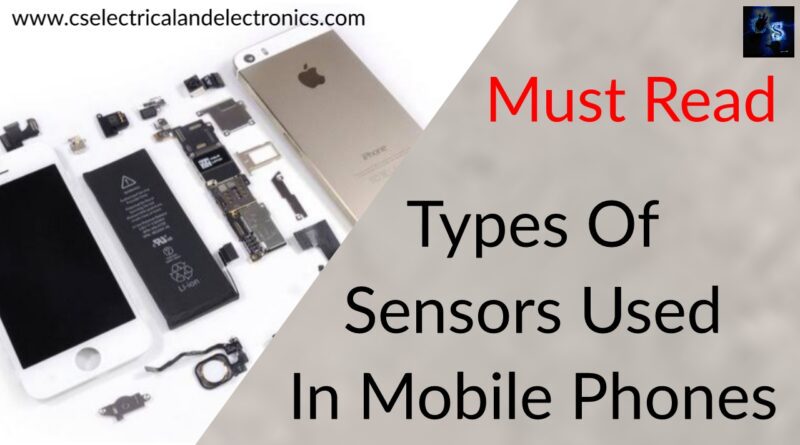Types Of Sensors Used In Mobile Phones, Sensors Used In Android Phones
Hello guys, welcome back to my blog. In this article, I will discuss the different types of sensors used in mobile phones, sensors used in android phones, why sensors are used in phones, etc.
If you have any doubts related to electrical, electronics, and computer science, then ask questions. You can also catch me on Instagram – Chetan Shidling.
- Applications Of IoT, Internet Of Things, What Is IoT, Latest Technology.
- What Is A Heat Sink, Working, Why Heat Sink Is Used, Alternatives.
- Types Of Automotive Sensors and Actuators Used In Electric Vehicles.
Types Of Sensors Used In Mobile Phones
Sensors are devices included in cellphones that sense different elements of their surroundings. They detect the data for which they were created and work following it. Sensors and sensing technologies may be used for a variety of purposes, including predictive and preventative maintenance. They not only ensure that measurement data is delivered more quickly, but they also improve accuracy, allowing for better process management and asset health.
A new generation of sensors can transmit data both wired and wirelessly, allowing for real-time, continuous data feeds from assets and operations. This gives executives a more comprehensive picture of a processing facility. Sensor-enabled businesses are more connected, secure, and agile than they have ever been.
In today’s smartphones, there are a variety of sensors that are built-in and aid in the operation of the device. Essentially, they strive to improve the user experience. Now, I will discuss the “Types Of Sensors Used In Mobile Phones”.
01. Sensors That Detect Movement
Tilt, shaking, rotation, and swing are all examples of device movement that may be monitored by motion sensors. Smartphones utilize an accelerometer to determine their orientation. Accelerometers have motion sensors that can be used to detect earthquakes or in medical equipment.
02. Sensors For The Environment
Temperature, humidity, and heat losses are detected using environmental sensors. Basically, it’s used to keep track of environmental variables. They create sensors such as gas sensors, humidity sensors, and so on.
03. Sensors Of Position
The Android smartphone has two sensors that may be used to detect the device’s location: a geomagnetic field sensor and an accelerometer sensor.
04. Sensor For Ambient Light
This sensor is used to adjust the screen’s brightness. It’s on virtually every smartphone, from mid-range to high-end. If you set your smartphone to Auto-brightness mode, your phone will automatically raise the brightness of the screen when you go outside in bright light. When you enter the dark, the phone’s brightness dims with the help of this sensor. This sensor controls the screen’s brightness based on the intensity of light.
05. The Sensor Of Proximity
They may be found at the top of nearly every smartphone’s screen. This sensor detects infrared light. Any physical thing senses and reacts to this when it comes into touch with it. Infrared light identifies tangible objects, such as your ear, when you chat on your phone and place it on your ear. The screen’s light turns off automatically when it detects this. This conserves battery life while also preventing unintentional screen touches.
06. The Sensor Of Acceleration
It is the most crucial sensor that should be included in every smartphone. It assists the phone in determining its orientation. Because of these sensors, when you rotate your phone in landscape mode, all icons on the screen also rotate to landscape mode, and you can shift it back to portrait mode whenever you like.
07. Sensor For Gyroscopes
You’ve likely heard of it. These sensors are the only ones that make virtual reality feasible. If you buy a VR headset and place your phone inside, you can only do so thanks to gyroscope sensors. Only these sensors allow for 360-degree photos or movies, as well as AR (Augmented Reality). These sensors allow the phone to precisely determine which axis (Angles and Directions) it is utilizing at any given time. Essentially, it adapts the contents of the phone to the user.
08. Sensor For A Barometer
These sensors aren’t found in every phone; they’re only found in high-end models. This is used to detect data about altitude (height). Every detail is carefully provided by the barometer sensor while ascending stairs or going from ground level to floor level, and data is transferred to GPS, which is then computed. It also aids with navigation.
09. The Sensor Of Compass
Compass sensors are fairly common and can be found in almost every phone. They assist in sensing direction in the same way that a traditional compass does. Other sensors exist that aren’t as crucial for Smartphones but are nonetheless present
10. Sensor For Pedometers
It keeps track of your steps and tells you how far you’ve gone. It’s only accessible on high-end smartphones and a few select models.
11. Hall Sensor
In comparison to phones, it is mostly employed in tablets. If you buy a flip case cover for your tablet, and you open it without pushing any buttons, the screen light will automatically turn on and the tablet will start, and when you shut the cover, the light will turn off.
12. IR Blaster (Infrared Blaster)
It is accessible on all XIAOMI phones, from entry-level to high-end. It is not accessible in phones for other companies. Electronic gadgets are controlled by these sensors. For example, if your phone has an IR Blaster, you may operate your TV, air conditioner, or any other electrical item from your phone.
Advantages Of Sensors
- Processing will be speed up and made more precise.
- Real-time data collection for processes and assets.
- Processes and assets must be correctly, consistently, and continually monitored.
- Increase productivity while lowering overall ownership costs.
- Reduced energy waste.
To sum up, In low-cost, low-maintenance systems, networking big sensor systems can enhance spatial and temporal sampling. A network of sensors installed throughout a big structure can provide data to a central processor, which can monitor performance or assist in the detection and classification of structural flaws.
I hope this article “Types Of Sensors Used In Mobile Phones” may help you all a lot. Thank you for reading “Types Of Sensors Used In Mobile Phones”.
Also, read:
- 100 + Electrical Engineering Projects For Students, Engineers
- 1000+ Electronics Projects For Engineers, Diploma, MTech Students
- 1000+ MATLAB Simulink Projects For MTech, Engineering Students
- 500+ Embedded System Projects For Engineer, Diploma, MTech, PhD
- 500+ Projects For Diploma Electrical, Electronics Student, Diploma Project
- 8051 Microcontroller Timers, TCON Register, TMOD Register
- Advancements In 3D Printing Technology And It’s Future
- Advancements In Power Electronics For Energy Efficiency
Author Profile
- Content Writer
Latest entries
 All PostsAugust 25, 2021Top 16 Highest Paying Engineering Jobs in the USA For Freshers
All PostsAugust 25, 2021Top 16 Highest Paying Engineering Jobs in the USA For Freshers All PostsAugust 23, 2021Top 10 Smart Cities In The World, Best Cities To Visit In The World
All PostsAugust 23, 2021Top 10 Smart Cities In The World, Best Cities To Visit In The World All PostsAugust 21, 2021Top 20 VLSI & Embedded Systems Projects for Mtech Students
All PostsAugust 21, 2021Top 20 VLSI & Embedded Systems Projects for Mtech Students All PostsAugust 21, 2021Top 20 Power Systems Projects For MTech Students, Engineering Students
All PostsAugust 21, 2021Top 20 Power Systems Projects For MTech Students, Engineering Students








